- Home
- Caring For Palms
- How to Water Palms
- Overwatering?
Overwatering Palm Trees
Overwatering palm trees can be an unexpected problem.
Because it seems as palms, coming from the tropics, must need lots of water. It's easy to think that more water equals a healthier plant. Yet it's not usually true. Yet, that information isn't always given when buying your palm.
If you wonder if your palm trees are getting too much water, we'll help you figure that out.
Feeling overwhelmed by so many palm trees?
You're not alone. We Understand your headaches! At Mission: Palm Trees you'll find clear answers to questions & Step-By-Step Guidance, from real people. With solutions to help. No puzzling shoptalk. No tiring research. So it's easy & fun for you.
How Do I Know If My Palm Tree is
Getting Too Much Water?
Your palm tree won't like being waterlogged. So it will show signs of complaint!
Too much water for palms creates health problems.
- Like most plants, palm trees need to get oxygen to their roots. Overwatering can waterlog the roots. They won't get access to that needed oxygen or nutrients.
- Constantly soggy roots invite root rot. Especially in young palms. It's a fungal attack that could kill.
- Root rot symptoms: pinkish coloring beginning to creep into stems. The roots will be getting mushy.
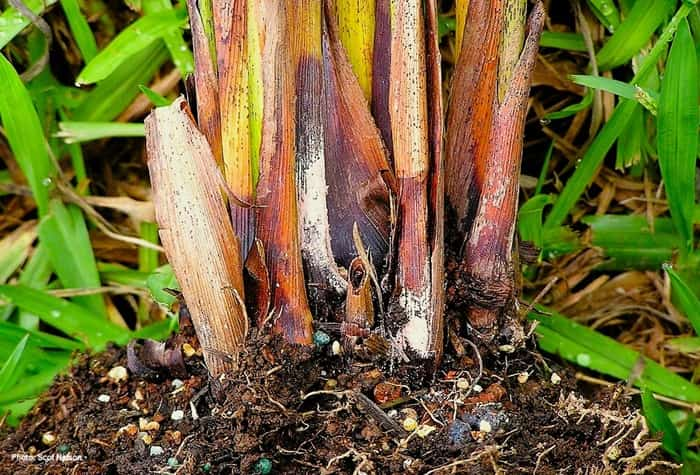 Areca Palm With Symptoms of Overwatering - Causing Root (Pink) Rot
Areca Palm With Symptoms of Overwatering - Causing Root (Pink) RotWhat are the other signs of overwatering palm trees?
- Most common is leaf wilting, from losing access to soil oxygen.
- Overly-soggy soils prevent the roots from drawing up Iron. Which in turn causes frond yellowing (chlorosis).
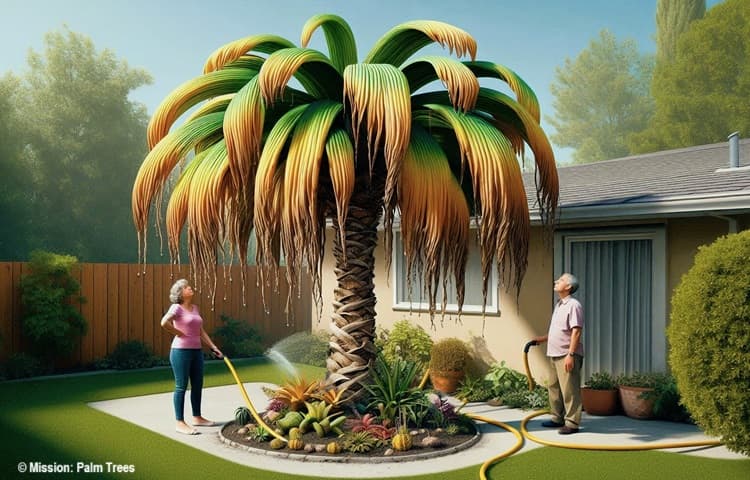
- Trunk areas can begin splitting - lengthwise in several places.
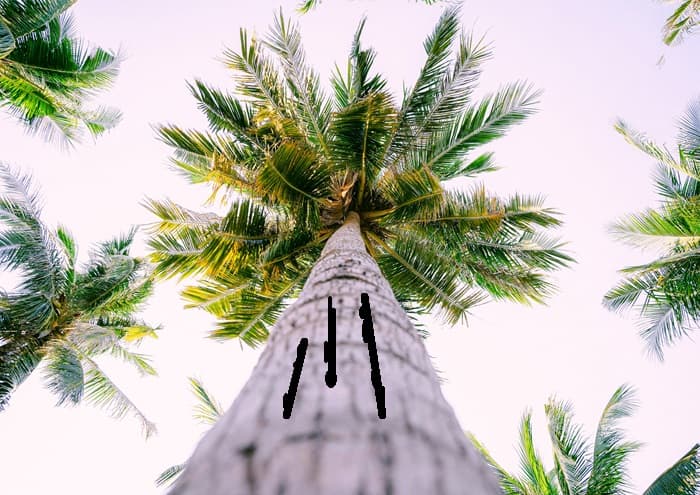 Example of Where Logitudinal Trunk Splitting is Seen
Example of Where Logitudinal Trunk Splitting is SeenHow Do I Avoid Overwatering Palm Trees?
The most essential way is prevention of overwatering your palm in the first place. That comes with knowing your own Palm Tree Species. Especially its original environmental needs
Like How Do I Water My Palm, how much sun, what kind of soil, etc.
Just like people, all palms are different. Some require more water, and others want drier conditions. In fact, palm trees usually tolerate underwatering much better than dealing with overwatering.
- The example of The Majesty Palm (Ravenea rivularis) needs lots of regular watering. It's said they can't get enough!
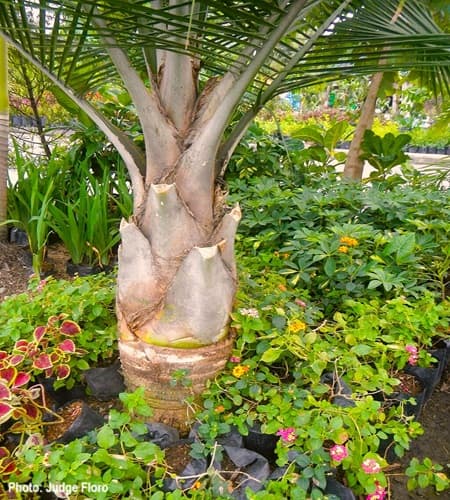 Majesty Palm Needs Regular Water
Majesty Palm Needs Regular WaterSome Surrounding Plants Should be Cleared Away.
- But the European Fan Palm (Chamaerops humilis) won't do well at all with lots of water.
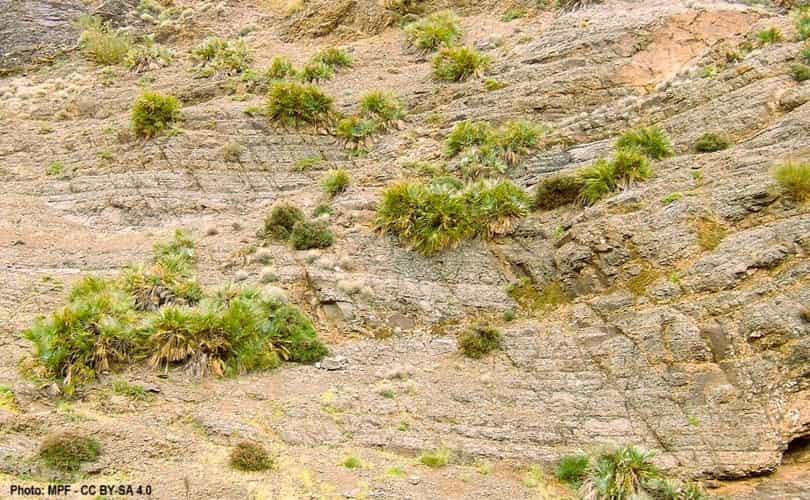 Scattered Mediterranean Fan Palms Growing on a Rocky Hillside in Morocco
Scattered Mediterranean Fan Palms Growing on a Rocky Hillside in MoroccoMore Tips to Help Prevent Overwatering Palms
FTC Disclosure: If clicking on a link or viewing ads on this page, we may earn a small royalty. There's no added cost to you. Thanks much for any looks/ orders! Details>
How Can Technology Help Prevent Overwatering Palm Trees?
If you're worrying about overwatering palm trees, we recommend you use A Moisture Meter.
- You stick its probe into the ground surrounding the palm
- A reading gives you the current moisture content. If the soil's still pretty wet, plan your next watering day according to the palm's requirement.
- It's a Handy Way to Stop Guessing if you're overwatering palm trees.
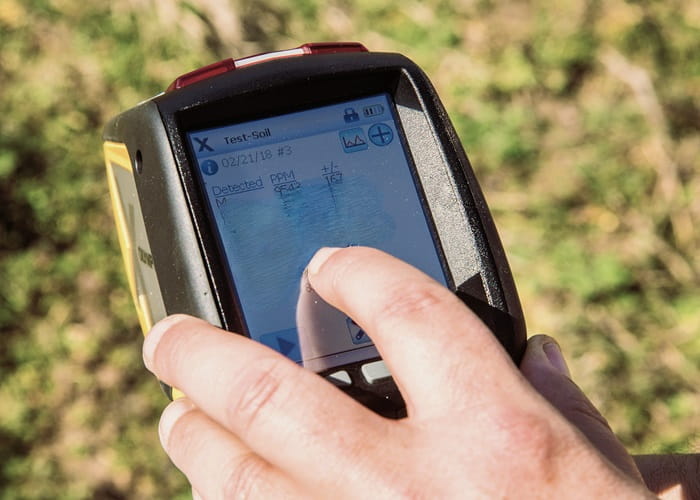 USDA Soil Analysis for Moisture Content & Nutrients
USDA Soil Analysis for Moisture Content & NutrientsThe Seasons of the Year Have Some Input!
Thinking about seasonal weather in your climate can help you adjust a watering schedule.
- Palm trees often need more water during the hot, dry summer months.
- Then taper back some in cool winter months.
- The amount of adjustment will depend on your typical local climate.
 How Are the Seasons Where You Live?
How Are the Seasons Where You Live?For instance, where we live there's a summer monsoon season. During July, August and into September we can get regular downpours.
When that's happening, I usually don't water at all!
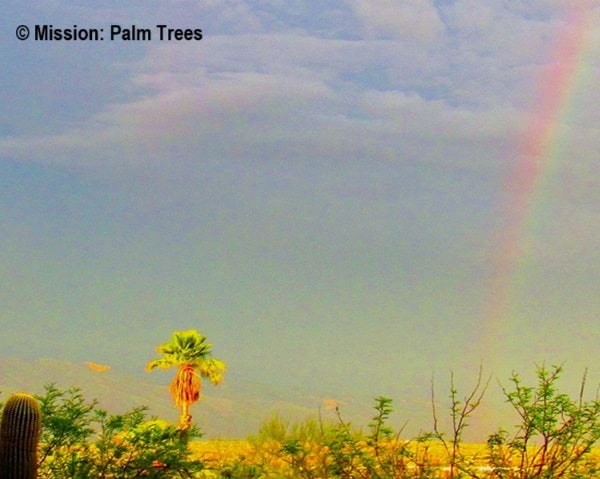 This Palm Doesn't Need Watering for Awhile, After a Monsoon Deluge!
This Palm Doesn't Need Watering for Awhile, After a Monsoon Deluge!Pic Taken From our Backyard in Tucson Arizona
Then, How Often Should Palm Trees be Watered?
The water requirements of any palm all goes back to Where the Palm Was Native. How it evolved and developed over time in its natural climate. And the type of locality it's been used to. So you'll know how to Care for That Palm you have.
- The Majesty Palm developed in swamps & along riversides in Madagascar. Where substantial water is immediately nearby.
- The European Fan Palm (also called the Mediterranean Fan) originally comes from coastal Mediterranean hills, where there's not abundant rainy days.
Once you know the details of your palm's native climate, you're on your way to preventing overwatering. What's helpful also, is overall details on How to Water Palm Trees.
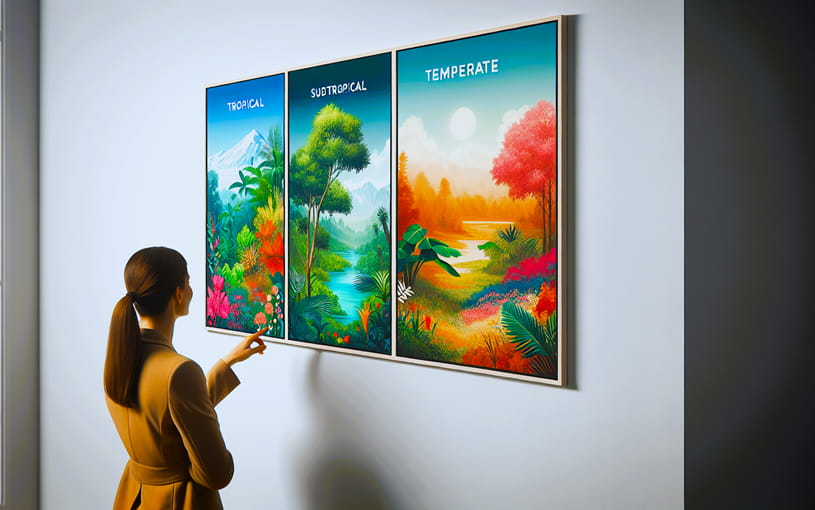 Your Palm Tree is Endemic to Which Climate? Knowing Helps With Correct Watering.
Your Palm Tree is Endemic to Which Climate? Knowing Helps With Correct Watering.Soil Can Contribute to Overwatering Palm Trees
The soil type your palm is planted in affects the amount of water staying around the roots.
The soil can give clues to an overwatering problem.
- Have you noticed a mossy mold, lichens or algae starting to appear on the trunk?
- Or growing nearby on the soil surface.
- That's a sign of the soil staying too wet.
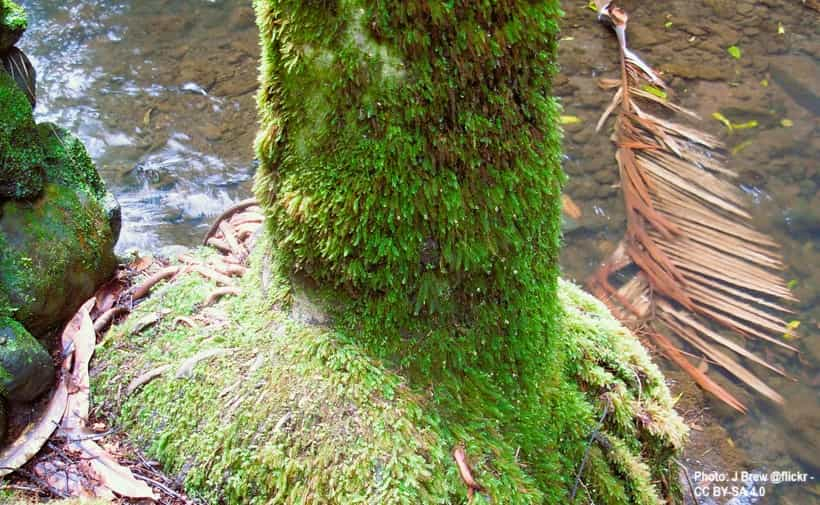 Alexandra Palm in the Hawaii Tropical Botanical Garden's Palm Jungle
Alexandra Palm in the Hawaii Tropical Botanical Garden's Palm JungleWhere It Gets So Much Moisture That Thick Moss Grows on the Trunk
Almost all palms need well-draining soil. Whether it's an Indoor Palm Tree or planted outdoors. Most Palm Tree Guide Books identify the soil that's best for various palms.
For potted Palms Used as Decor Indoors, be sure the soil in Your Good-Draining Planter allows water to be free-flowing.
When Planting a New Palm, it's best to do a "Perk Test" - which tells you how quickly or slowly water drains in that spot. You'll want to know if the planting site has good drainage.
How Do You Fix an Overwatered Palm Tree?
Our Latest Article
-
Backyard Palm Tree Ideas Make Your Space Feel Like a Tropical Escape
Bring a resort feel home. Explore inspiring backyard palm tree ideas with themes like clustering, layering, and lighting designs for any space.
If you're seeing signs that your palm has been getting too much water, don't be overly alarmed.
We have a corrective plan to help you in that situation.
- The most important thing is to hold up on your typical watering schedule. To let the soil to dry out.
- It may take a bit of time for soil to dry. Even up to a week or more. Soil and climate conditions affect that.
- The idea is to allow the roots to get to the oxygen - which can solve many problems.
- Good air movement surrounding the palm can help. Ensure other plants aren't packed too closely around it.
A Good Rule Of Thumb going forward is letting the top inch or two of soil dry out before watering again.
Fix an Overwatered Container Palm Tree
Potted palm trees, especially those palms kept indoors, need more watchfulness.
Indoor Palm Trees have a much lower life-span than outdoor palms. Most average from 5-7 years of life. Sometimes getting to 10 years. If that's yours, you're lucky & have done a good job.
The first temporary step is letting the soil dry out.
- Most palms tolerate vastly decreased soil moisture for a short time.
- Then restart watering with a schedule that matches what your species of palm needs. Your wait probably won't be much more than once a week.
- For better evaluation, see this water drainage testing:
How to Think about Repotting My Indoor Palm Tree
With a container palm, it may be time for repotting.
- And repotting may be needed, if your palm shows signs of overwatering.
- Or if you've had it awhile & the roots might need more room. A Hint: are any roots coming out of the pot's drainage holes.
- But consider, most indoor palms grow extremely slowly. So they won't need to grow many more roots.
When replanting because of suspected overwatering, be very gentle. The palm heart could be damaged, which would cause palm tree death.
Tips for Transplanting Your Indoor Palm
Have some items on hand and ready before starting.
- A new Larger, Deeper Container. Be sure it is clean & has good drainage openings.
- Get your ideal time-release 18N-6P-12K fertilizer (=3N-1P-2K - remember your math? For doing proportions? 🤔). Or as Close to That as Possible.
- A bag of the appropriate indoor palm planting medium.
You can use a mixture of two parts Cocopeat or Coir Dust, one part Clean Sand, one part Dolomite & one part Crushed Pine Bark or Wood Shavings.
Or use a Prepared Planting Substrate that can work for palms.
First place a thin layer of dolomite at the pot's bottom. Then add a small layer of your prepared or purchased palm substrate medium.
- Carefully lift the palm by lifting it from the very bottom.
- Cautiously brush loose soil from the roots. You don't have to get every bit.
- Scan the roots. Cleanly trim any mushy and/or blackish-brown roots. Palm roots typically regenerate.
- But be careful not to trim any too close to the trunk.
Place your transplanted palm into the pot. Steadying it in the center, loosely fill the medium around the roots.
IMPORTANT - Be sure the palm "soil" rises to the very same level which it had prior to transplanting - not lower or higher.
Water the palm gently. Then wait a little while for the potting substrate to settle. Look to see if you need to add any more to bring it to the same level it's used to.
Takeaways for Overwatering Palm Trees
How often should you water your palm tree? So it doesn't stay waterlogged.
Overwatering palm trees is common, yet preventable issue.
You've now learned the signs of overwatering. It's a delicate balance to adjust your watering habits. But if you base it on the needs of your specific palm you won't have that Palm Problem.
Along with watering needs of your palm species, remember to have well-draining soil. Then the next time you reach for the watering can or hose, you'll know to consider whether your palm tree really needs water.





